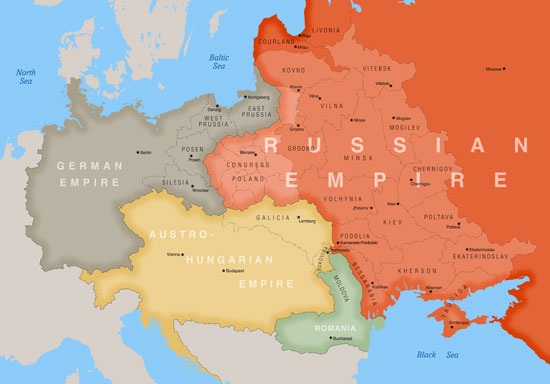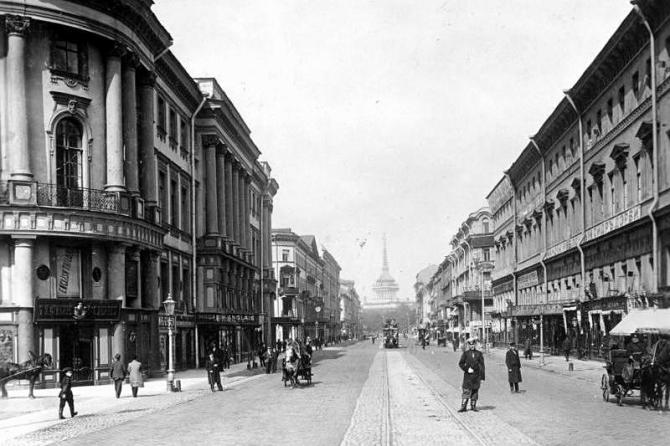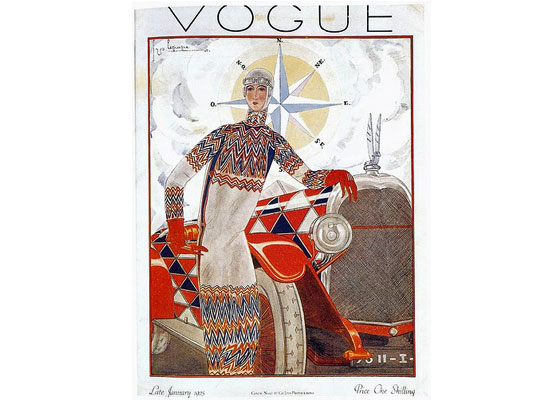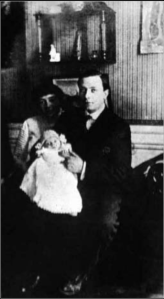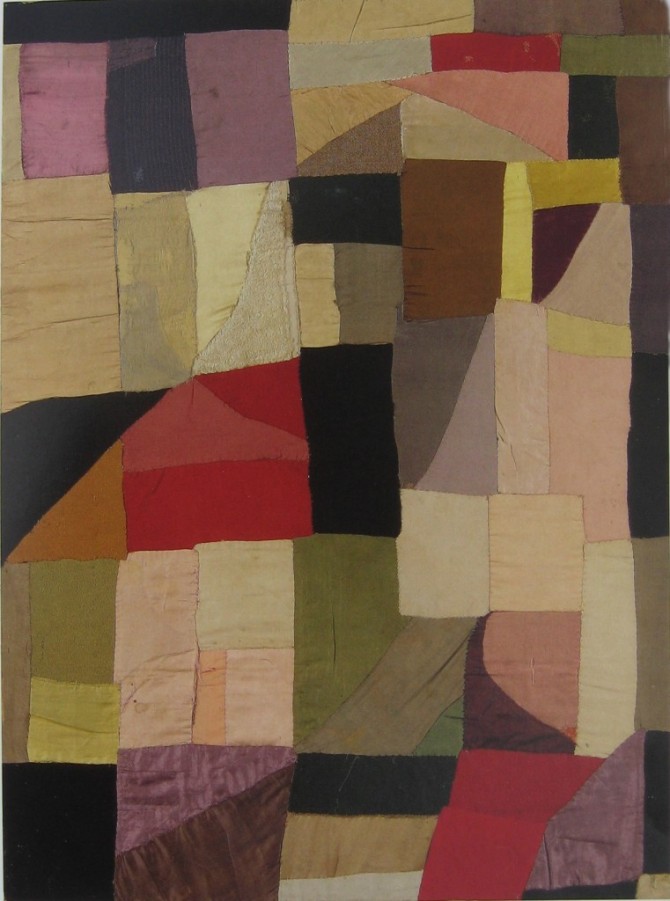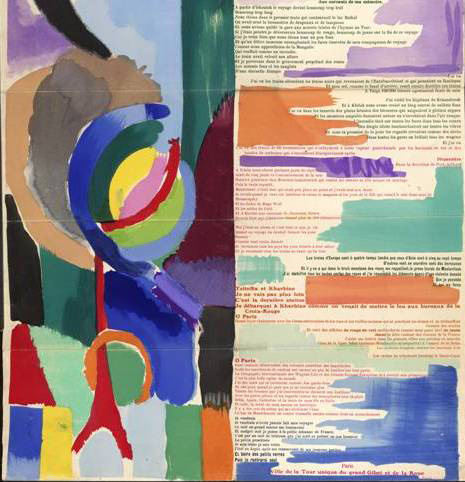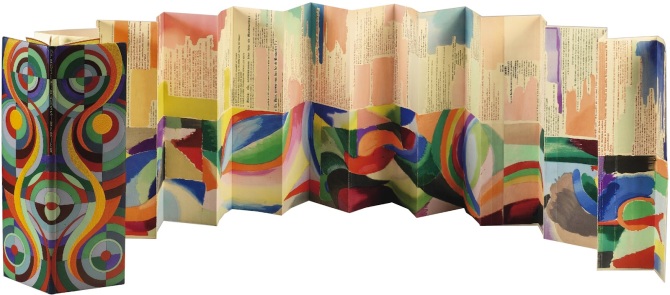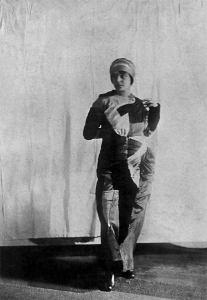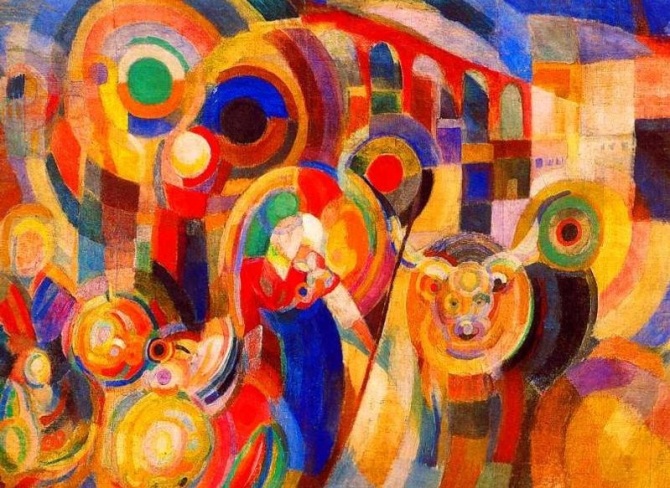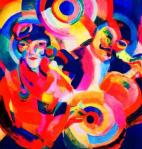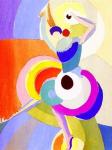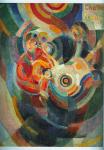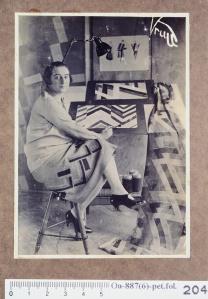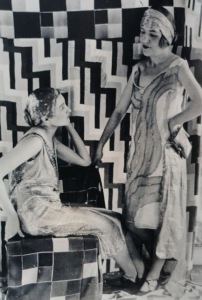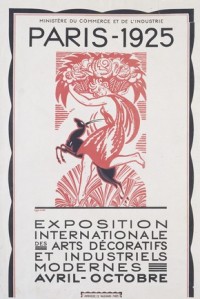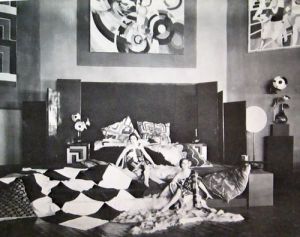- Who is Sonia Delaunay?
- What is her background?
- How did she start her career as an abstract artist?
- What are her key artworks?
- Where has she exhibited her work?
- What color is this dress?
- Project
- Show Time!
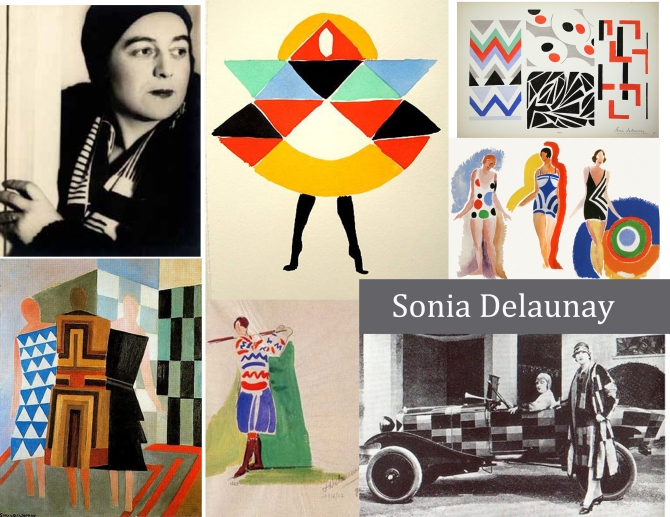
Who is Sonia Delaunay?
Sonia Delaunay – Terk (November 14, 1885 – December 5, 1979)
Sonia Delaunay was a multi-disciplinary abstract artist and key figure in the Parisian avant-garde. Alongside her husband, Robert Delaunay, she pioneered the movement Simultanism. Her exploration of the interaction between colors has created a sense of depth and movement throughout her artwork.
- How long did Sonia live?
- What other artists that lived around 1900 do you remember? Where did they live?
- What events happened during Sonia’s lifetime?
Sonia Delaunay was born on November 15th, 1885, in a small town of the Russian Empire, now in Ukraine. Little is known about the first twenty years of her life other than she was born Sarah Stern and when still a young child she was sent to St. Petersburg to be raised by a wealthy uncle and his wife and that she adopted their surname and changed her name to Sonia Terk.
Sonia received a privileged upbringing in her Jewish uncle affluent home. She always recalled St. Petersburg‘s great avenues, palaces, gardens and great art collections. She spent summers in Finland and traveled widely in Europe. As a young girl she was fascinated by mathematics and later geometry became, together with color, the cornerstone of her art. When she was sixteen her art teacher encouraged Sonia to continue the art education in Germany. She was sent to study at the Academy of Fine Arts in Karlsruhe, Germany until 1905.
Although she never returned to her birthplace, she always attributed her love of color to her memories of the bright Ukrainian sun of her early childhood and she often referred back to the ‘pure’ colour and bright costumes of the Ukrainian peasant weddings.
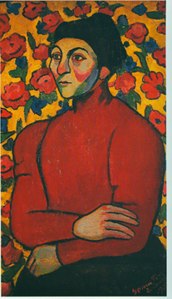
How did she start her career as an abstract artist?
After two years of art study in Germany, Sonia persuaded the Terks to let her go to Paris – the center of “it’s what’s happening” – for a year. In Paris she saw the work of van Gogh, Gaugain, and the Fauves. Many years later she wrote of what she learned from them… “The real new painting will begin when people will understand that color has a life of its own, that the infinite combinations of color have a poetry and a language much more expressive than the old methods. It is a mysterious language in tune with the vibrations, the life itself, of color. In this area there are new and infinite possibilities.”
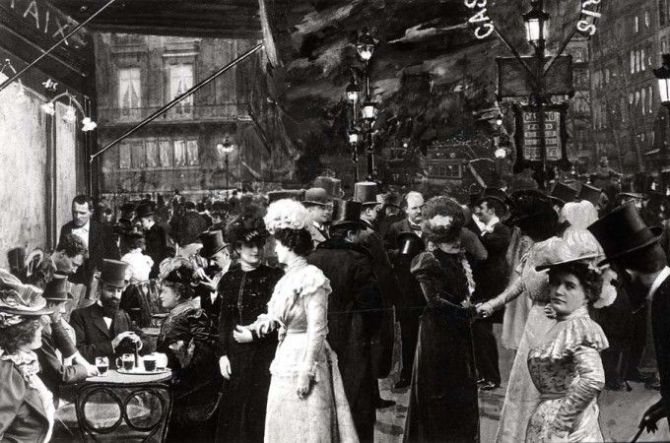
1900 Paris Cafe de la Paix. What do you notice in this picture? How is the fashion in 1900?
In Paris, Sonia met the young painter Robert Delaunay in 1907. They married and their son Charles was born January 1911. Robert’s early paintings had been influenced by impressionism and cubism but he and Sonia turned their attention jointly towards abstraction. Following the nineteenth-century chemist Michel Eugène Chevreul, who studied how the perception of colours seems to change when they are placed alongside each other, Sonia and Robert developed a theory of simultaneous colour contrasts which they called simultanism. Sonia began to apply these theories to a variety of forms. Shortly after the birth of their son Charles, she made him a patchwork cradle cover, bringing together the traditional techniques used by Russian peasant women with modernist abstraction.
“About 1911 I had the idea of making for my son, who had just been born, a blanket composed of bits of fabric like those I had seen in the houses of Russian peasants. When it was finished, the arrangement of the pieces of material seemed to me to evoke cubist conceptions and we then tried to apply the same process to other objects and paintings.”
In 1913 Sonia befriended the poet Blaise Cendrars. Together they created Prose on the Trans-Siberian Railway and of Little Jehanne of France 1913, in which the poet’s fictional recounting of a journey from Moscow to Paris is interpreted through Sonia’s abstract stencil illustrations.
The poem does not end at Harbin, the eastern terminus of the line, however, but in Paris, which is represented by the Eiffel Tower and the Big Wheel (La Roue) at the bottom. The Eiffel Tower, the tallest building in Paris, has also served as a radio tower since the early twentieth century. It is thus a symbol of Paris’s connection to the world as well as of modernity. Cendrars and Delaunay also intended another connection to the Eiffel Tower: they initially planned to print 150 copies of the book, which measures two meters long. If laid end-to-end, together they would have equaled the tower’s height.
The colour and dynamism of simultanism was particularly suited to capturing the remarkable energy of city life in the early twentieth century. Sonia’s Electric Prisms series explored the distinctive effects of electric lighting, while her studies of the Boulevard Saint Michel and her billboard projects for luxury brands such as Zenith show a fascination with the changing fabric of the urban landscape.
Sonia Delaunay in Simultaneous dress, c. 1913
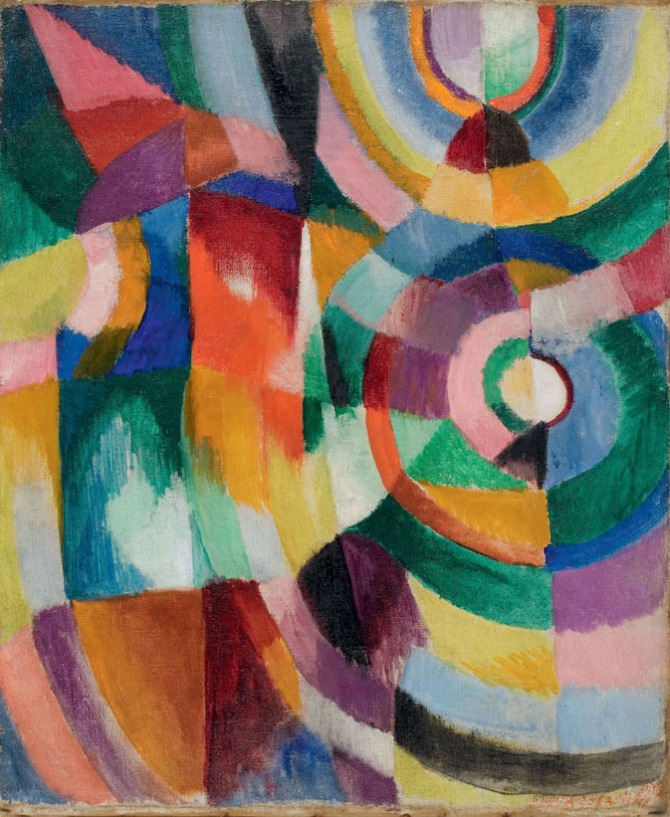
At the outbreak of the First World War, Sonia and Robert were on holiday in the Basque town of Hondarribia in northern Spain. They decided not to return to Paris and spent the next seven years travelling within Spain and Portugal.
While living in Spain, Sonia began to support herself and her husband by working as decorator.
After their return to Paris in 1920 Sonia was mainly active as designer of fabrics and clothes in styles related to her paintings. There was a huge demand for Sonia’s fabric designs, and she employed a team of Russian women to manufacture, knit and embroider her products. In 1925 she set up her own fashion house, and registered Simultané as a brand name in both France and the United States.
Sonia showcased her simultaneous designs at the 1925 International Exhibition of Modern Industrial and Decorative Arts in a pavilion called boutique simultané.
Look at the 1925 fashion showcased by these models. How does it compare with the 1900s?
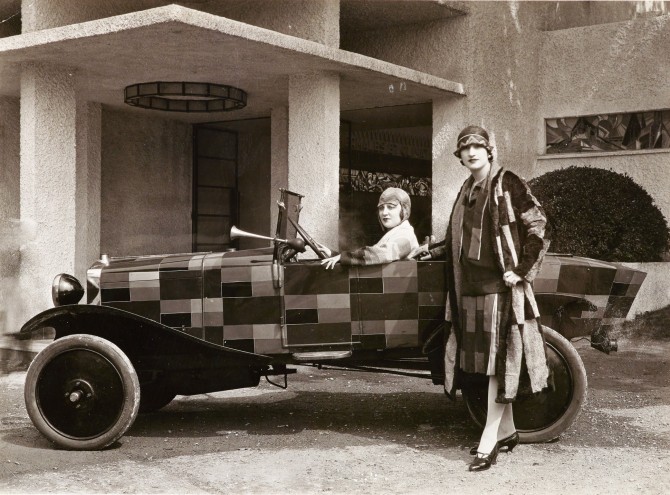
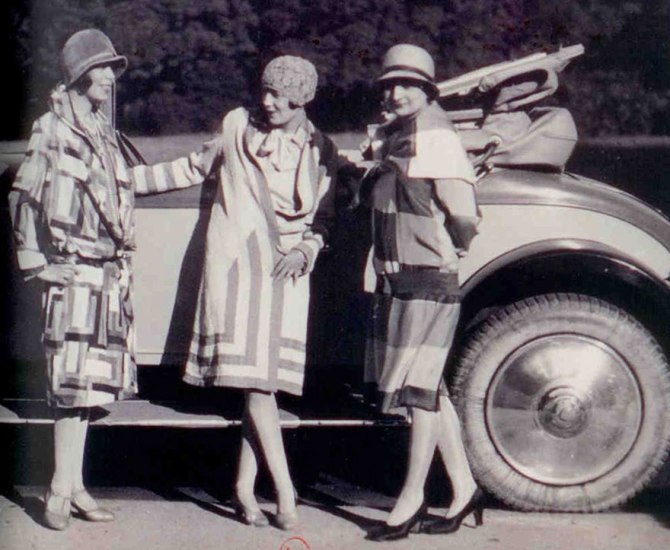
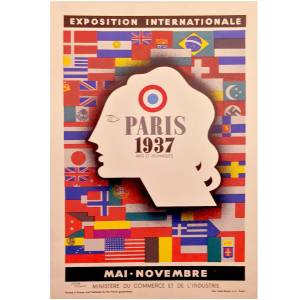
Sonia and Robert were both invited to contribute to the 1937 Paris Exhibition.
Entitled The International Exhibition of Arts and Technology in Modern Life, it was intended to celebrate scientific innovation and boost trade.
As a team, the Delaunays collaborated on both domestic interiors and set design, creating several impressive wall-sized murals for the Paris World’s Fair of 1937.
“I always changed everything around me… I made my first white walls so our paintings would look better. I designed my furniture; I have done everything. I have lived my art.”
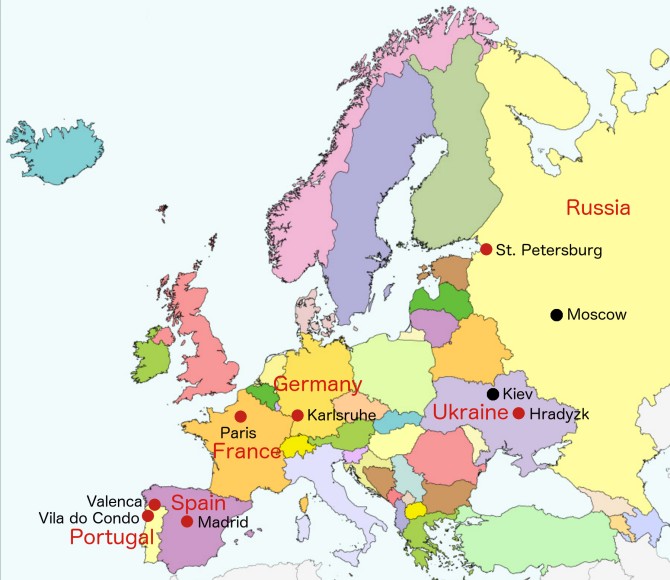
Where has she exhibited her work?
As well as a major retrospective at the Kunstmuseum Bielefeld in 1958, Delaunay was the first living female artist to have a retrospective exhibition at the Louvre in 1964. She has also had her work shown at Musée d’Art Moderne in Paris, Smithsonian Cooper-Hewitt, National Design Museum, Musée des Arts Décoratifs, Musée National d’Art Moderne and Tate Modern.
Let’s see Sonia’s colors at Musée d’Art Moderne de la Ville de Paris!
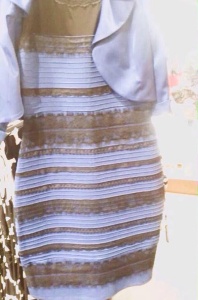
What color is this dress? – The art and science of color!
Color interaction was first put on a sound experimental base by the French chemist Michel Chevreul (1786-1889). Chevreul was hired by the Gobelin Tapestry factory to investigate the fading of their tapestry threads.
In his 1839 book, De la Loi du Contraste Simultané des Couleurs, Chevreul shows that the fading is not fading at all, but instead due to simultaneous contrast between adjacent colored threads.
For example, a grey will look lighter on a dark background than it does on a light one.
Demonstration of contrast sensitivity
You can also try this experiment at home: Color Contrast
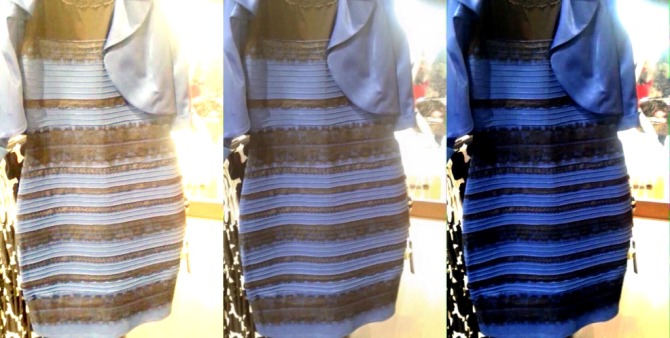
PROJECT: Black Paper, Oil Pastels (Light Design)
On black paper, using circles and other geometric shapes, organize the space with ruler lines and circles with protractors. Drwaing with a pencil, keep the space large enough to handle oil pastels and simple enough to make the designs intersect and incorporate many colors.

